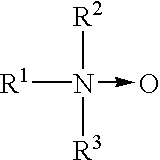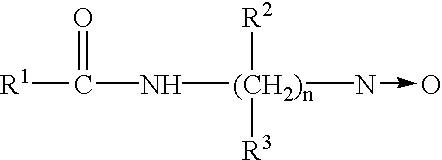Method for eliminating malodors
a malodor and emulsion technology, applied in the field of mitigating or eliminating malodors, can solve the problems that staller's emulsion cannot be dosed from a dispenser or other convenient metering device, and cannot be taught, disclosed, or suggested, and achieve the effect of reducing or reducing any undesirable foaming
- Summary
- Abstract
- Description
- Claims
- Application Information
AI Technical Summary
Benefits of technology
Problems solved by technology
Method used
Image
Examples
example 1
Aqueous Liquid Malodor Eliminating / Mitigating Composition
These ingredients are merely admixed together, with gentle stirring. The preferred order of addition is to disperse the fragrance via the surfactant and to neutralize the polymer (although one can purchase versions that are already neutralized). So, to disperse the fragrance adequately, a preblend of water, surfactant and fragrance, and then this preblend is added to the bulk of the product. The finished liquid malodor mitigating composition can then be loaded into trigger or pump sprayers. Preferably, but by no means limiting to the invention, the composition is delivered in a trigger sprayer made of high density polyethylene (HDPE) or polypropylene, although it is desirable to use transparent polyvinyl chloride (PVC) or, especially, polyethylene terphthalate (PET), and other transparent or translucent thermopolymers. Examples of such sprayers are depicted in Hefter et al., U.S. Des Pat. No. 404,650, Bolliger et al., U.S. Des...
example 2
To the above base formulation, a number of different water soluble or dispersible polymers were tested. While all were acceptable, some were preferred due to aesthetic criteria.
In the next set of examples, drying time differences between the higher solvent level formulas (9%) demonstrated that such higher solvent levels are preferred for product performance.
examples 3-5
Cotton / polyester and Cotton / acrylic blend swatches were dosed with 0.6 to 0.9 g of two different formulas, one having the constituents depicted in Example 1, above, the second, having 9% ethanol. Each wetted swatch was promptly weighed to get an initial weight, and then weighed again at 12, 18 and 24 minute intervals. Samples were randomized. The difference between drying times for the two different formulas were averaged, the standard deviations and the 95% confidence intervals were then determined.
TABLE 2
Drying Time Improvements
The next set of examples depict aerosol formulations. However, cost, the presence of an additional solvent (the propellant) and the ensuing reduction in water content, are considerations in aerosol delivery. If aerosol delivery is practiced, there are also preferred systems described in co-pending patent application Ser. No. 09 / 116,190, of Boli Zhou et al, filed Jul. 15, 1998, now U.S. Pat. No. 6,080,387 and incorporated herein by reference.
PUM
| Property | Measurement | Unit |
|---|---|---|
| molecular weight | aaaaa | aaaaa |
| vapor pressure | aaaaa | aaaaa |
| Vapor pressure | aaaaa | aaaaa |
Abstract
Description
Claims
Application Information
 Login to View More
Login to View More - R&D
- Intellectual Property
- Life Sciences
- Materials
- Tech Scout
- Unparalleled Data Quality
- Higher Quality Content
- 60% Fewer Hallucinations
Browse by: Latest US Patents, China's latest patents, Technical Efficacy Thesaurus, Application Domain, Technology Topic, Popular Technical Reports.
© 2025 PatSnap. All rights reserved.Legal|Privacy policy|Modern Slavery Act Transparency Statement|Sitemap|About US| Contact US: help@patsnap.com



